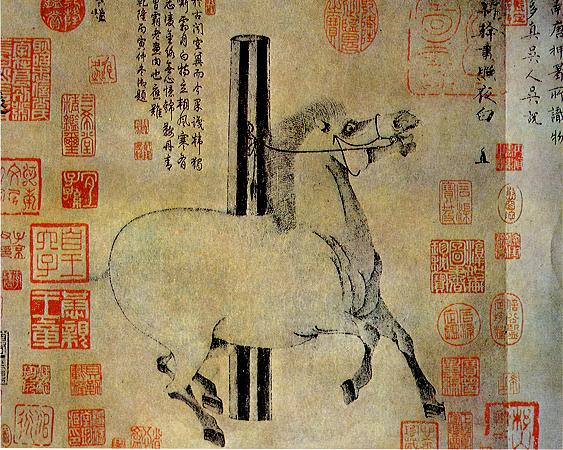
Early Taoists promoted simplicity, in working with the intrinsic nature of a thing.
They believed in the equality of mankind and all the creatures of The Earth and that we could all live together as a harmonious whole. They also believed that when we mankind, tried to impose our will on others, without consideration for what is inherently best, we could cause damage at core level.
Chuang Tzu, along with the Taodejing, is one the two major foundation works of Taoist philosophy.
Chuang Tzu is attributed to Chuang Tzu (born circa 369 B.C.) and his work is simply called after him. Chuang Tzu conveys his message to us in stories and parables using scenes from everyday life that we can relate to. The stories have many layers and can be interpreted on different levels.
In the chapter ‘Horse’s Hoofs’ Chuang Tzu uses the imagery of horses as they’re so visually beautiful and expressive, to get our attention about how much damage can be done by us when things aren’t treated according to their true nature.
He also conveys to us in ‘Horses’ Hoofs’ that when something has popular appeal as being the correct thing to do, it’s very hard to change people’s opinion on it.
Chuang Tzu mentions Po Lo in ‘Horses’ Hoofs’. Po Lo was widely considered to be a great horse trainer and very knowledgeable about horses – but Chuang Tzu didn’t hold Po Lo in high regard at all.
This is from Burton Watson’s translation of Chuang Tzu, Chapter 9 ‘Horses’ Hoofs’.
Then along comes Po Lo. “I’m good at handling horses!” he announces, and proceeds to singe them, shave them, pare them, brand them, bind them with martingale and crupper, tie them up in stable and stall. By this time two or three out of ten horses have died. He goes on to starve them, make them go thirsty, race them, prance them, pull them into line, force them to run side by side, in front of them the worry of bit and rein, behind them the terror of whip and crop. By this time over half the horses have died.
…. And yet age after age men have praised Po-lâo, saying, “He knew well how to manage horses”.
Although it’s sad to hear about how some horses were treated 2,500 years ago in China, it’s wonderful to know there was such awareness back then about the importance of keeping our domesticated horses in a way that suits their inherent nature.
And it’s also interesting to note that because of Po Lo’s reputation, people followed him without question.
Taoists were not against using and working with animals at all, so long as they were treated fairly in a manner that suited them. Even though ‘Horses’ Hoofs’ gives a bad report of the way horses were treated in some cases in ancient China, it’s likely, and it would be good to think that many horses were treated well by their owners too, as they have such a way of inspiring love and emotion in people.
Chuang Tzu goes on to add that when something is not treated according to it’s true nature, it not only physically damages it, it also damages it’s intrinsic character.
When horses live on the plain, they eat grass and drink from the streams. Pleased, they twine their necks together and rub; angry, they turn back to back and kick. This is all horses know how to do. But if you pile poles and yokes on them and line them up in crossbars and shafts, then they will learn to snap the crossbars, break the yoke, rip the carriage top, champ the bit, and chew the reins. Thus horses learn how to commit the worst kinds of mischief. This is the crime of Po Lo.
Chuang Tzu shows here that when we carelessly subject horses to our will, it changes their natural behaviour, their inborn nature as he calls it.
It’s so easy to see parallels with this today and we might wonder how far have we come?
Although the overwhelming majority of people treat horses very well, there are still gaps.
I wonder is it just in the nature of some to not regard animals as highly as others, were they born like that? Is it to do with geographical location? Or is it because their way of treating them has poplar appeal in their circle? Or is a lot of it genuine lack of knowledge?
The writings of Chuang Tzu bridge a gap in time for us and give us vivid and immediate pictures of situations that we can reflect on. We can use them to examine not only ourselves individually, but also society in all it’s diverse parts, as well as society a whole – if that is not too big to encompass.
If you’d like me to send you 5 Posture Tips To Enhance Your Chi Flow Riding, please click here